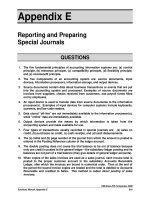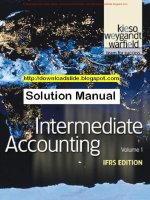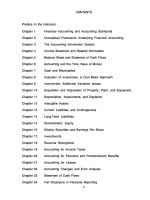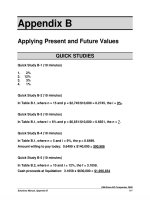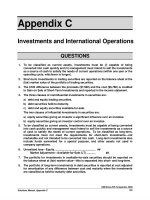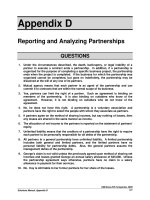Solution manual intermediate accounting 4e by spiceland
Bạn đang xem bản rút gọn của tài liệu. Xem và tải ngay bản đầy đủ của tài liệu tại đây (4.77 MB, 1,594 trang )
To download more slides, ebook, solutions and test bank, visit
Chapter 1
Environment and Theoretical Structure of
Financial Accounting
QUESTIONS FOR REVIEW OF KEY TOPICS
Question 1-1
Financial accounting is concerned with providing relevant financial information about various
kinds of organizations to different types of external users. The primary focus of financial accounting
is on the financial information provided by profit-oriented companies to their present and potential
investors and creditors.
Question 1-2
Resources are efficiently allocated if they are given to enterprises that will use them to provide
goods and services desired by society and not to enterprises that will waste them. The capital
markets are the mechanism that fosters this efficient allocation of resources.
Question 1-3
Two extremely important variables that must be considered in any investment decision are the
expected rate of return and the uncertainty or risk of that expected return.
Question 1-4
In the long run, a company will be able to provide investors and creditors with a rate of return
only if it can generate a profit. That is, it must be able to use the resources provided to it to generate
cash receipts from selling a product or service that exceeds the cash disbursements necessary to
provide that product or service.
Question 1-5
The primary objective of financial accounting is to provide investors and creditors with
information that will help in evaluating the amounts, timing, and uncertainty of a business
enterprise’s future cash receipts and disbursements.
Question 1-6
Net operating cash flows are the difference between cash receipts and cash disbursements
during a period of time from transactions related to providing goods and services to customers. Net
operating cash flows may not be a good indicator of future cash flows because, by ignoring
uncompleted transactions, they may not match the accomplishments and sacrifices of the period.
Solutions Manual, Vol.1, Chapter 1
© The McGraw-Hill Companies, Inc., 2008
1-1
To download more slides, ebook, solutions and test bank, visit
Answers to Questions (continued)
Question 1-7
GAAP (generally accepted accounting principles) are a dynamic set of both broad and specific
guidelines that a company should follow in measuring and reporting the information in their
financial statements and related notes. It is important that all companies follow GAAP so that
investors can compare financial information across companies to make their resource allocation
decisions.
Question 1-8
In 1934, Congress created the SEC and gave it both the power and responsibility for setting
accounting and reporting standards for companies whose securities are publicly traded. The SEC
has retained the power, but has delegated the responsibility to private sector bodies. The current
private sector body responsible for setting accounting standards is the FASB.
Question 1-9
Auditors are independent, professional accountants who examine financial statements to
express an opinion. The opinion reflects the auditors’ assessment of the statements' fairness, which
is determined by the extent to which they are prepared in compliance with GAAP. The auditor adds
credibility to the financial statements, which increases the confidence of capital market participants
relying on that information.
Question 1-10
On July 30, 2002, President Bush signed into law the Sarbanes-Oxley Act of 2002. The most
dramatic change to federal securities laws since the 1930s, the Act radically redesigns federal
regulation of public company corporate governance and reporting obligations. It also significantly
tightens accountability standards for directors and officers, auditors, securities analysts and legal
counsel. Student opinions as to the relative importance of the key provisions of the act will vary.
Key provisions in the order of presentation in the text are:
Creation of an Oversight Board
Corporate executive accountability
Non-audit services
Retention of work papers
Auditor rotation
Conflicts of interest
Hiring of auditor
Internal control
Question 1-11
New accounting standards, or changes in standards, can have significant differential effects on
companies, investors and creditors, and other interest groups by causing redistribution of wealth.
There also is the possibility that standards could harm the economy as a whole by causing
companies to change their behavior.
© The McGraw-Hill Companies, Inc., 2008
1-2
Intermediate Accounting,Revised 4/e
To download more slides, ebook, solutions and test bank, visit
Answers to Questions (continued)
Question 1-12
The FASB undertakes a series of elaborate information gathering steps before issuing a
substantive accounting standard to determine consensus as to the preferred method of accounting, as
well as to anticipate adverse economic consequences.
Question 1-13
The purpose of the conceptual framework is to guide the Board in developing accounting
standards by providing an underlying foundation and basic reasoning on which to consider merits of
alternatives. The framework does not prescribe GAAP.
Question 1-14
Relevance and reliability are the primary qualities that make information decision-useful.
Relevant information will possess predictive and/or feedback value and also will be provided in a
timely manner. Reliability is the extent to which information can be relied upon by users.
Question 1-15
The components of relevant information are predictive and/or feedback value and timeliness.
The components of reliable information are verifiability, representational faithfulness, and
neutrality.
Question 1-16
The benefit from providing accounting information is increased decision usefulness. If the
information is relevant and reliable, it will improve the decisions made by investors and creditors.
However, there are costs to providing information that include costs to gather, process and
disseminate that information. There also are costs to users in interpreting the information as well as
possible adverse economic consequences that could result from disclosing information. Information
should not be provided unless the benefits exceed the costs.
Question 1-17
Information is material if it is deemed to have an effect on a decision made by a user. The
threshold for materiality will depend principally on the relative dollar amount of the transaction
being considered. One consequence of materiality is that GAAP need not be followed in measuring
and reporting a transaction if that transaction is not material. The threshold for materiality has been
left to subjective judgment.
Solutions Manual, Vol.1, Chapter 1
© The McGraw-Hill Companies, Inc., 2008
1-3
To download more slides, ebook, solutions and test bank, visit
Answers to Questions (continued)
Question 1-18
1. Assets are probable future economic benefits obtained or controlled by a particular entity
as a result of past transactions or events.
2. Liabilities are probable future sacrifices of economic benefits arising from present
obligations of a particular entity to transfer assets or provide services to other entities in the future as
a result of past transactions.
3. Equity is the residual interest in the assets of any entity that remains after deducting its
liabilities.
4. Investments by owners are increases in equity resulting from transfers of resources, usually
cash, to a company in exchange for ownership interest.
5. Distributions to owners are decreases in equity resulting from transfers to owners.
6. Revenues are inflows of assets or settlements of liabilities from delivering or producing
goods, rendering services, or other activities that constitute the entity’s ongoing major or central
operations.
7. Expenses are outflows or other using up of assets or incurrences of liabilities during a
period from delivering or producing goods, rendering services, or other activities that constitute the
entity’s ongoing major or central operations.
8. Gains are defined as increases in equity from peripheral or incidental transactions of an
entity.
9. Losses represent decreases in equity arising from peripheral or incidental transactions of an
entity.
10. Comprehensive income is defined as the change in equity of an entity during a period from
nonowner transactions.
Question 1-19
The four basic assumptions underlying GAAP are (1) the economic entity assumption, (2) the
going concern assumption, (3) the periodicity assumption, and (4) the monetary unit assumption.
Question 1-20
The going concern assumption means that, in the absence of information to the contrary, it is
anticipated that a business entity will continue to operate indefinitely. This assumption is important
to many broad and specific accounting principles such as the historical cost principle.
Question 1-21
The periodicity assumption relates to needs of external users to receive timely financial
information. This assumption requires that the economic life of a company be divided into artificial
periods for financial reporting. Companies usually report to external users at least once a year.
Question 1-22
The four key broad accounting principles that guide accounting practice are (1) the historical
cost or original transaction value principle, (2) the realization or revenue recognition principle, (3)
the matching principle, and (4) the full disclosure principle.
© The McGraw-Hill Companies, Inc., 2008
1-4
Intermediate Accounting,Revised 4/e
To download more slides, ebook, solutions and test bank, visit
Answers to Questions (concluded)
Question 1-23
Two important reasons to base valuation on historical cost are (1) historical cost provides
important cash flow information since it represents the cash or cash equivalent paid for an asset or
received in exchange for the assumption of a liability, and (2) historical cost valuation is the result of
an exchange transaction between two independent parties and the agreed upon exchange value is,
therefore, objective and possesses a high degree of verifiability.
Question 1-24
The realization principle requires that two criteria be satisfied before revenue can be
recognized:
1. The earnings process is judged to be complete or virtually complete, and,
2. There is reasonable certainty as to the collectibility of the asset to be received (usually
cash).
Question 1-25
The four different approaches to implementing the matching principle are:
1. Recognizing an expense based on an exact cause-and-effect relationship between a revenue
and expense event. Cost of goods sold is an example of an expense recognized by this
approach.
2. Recognizing an expense by identifying the expense with the revenues recognized in a
specific time period. Office salaries is an example of an expense recognized by this
approach.
3. Recognizing an expense by a systematic and rational allocation to specific time periods.
Depreciation is an example of an expense recognized by this approach.
4. Recognizing expenses in the period incurred, without regard to related revenues.
Advertising is an example of an expense recognized by this approach.
Question 1-26
In addition to the financial statement elements arrayed in the basic financial statements,
information is disclosed by means of parenthetical or modifying comments, notes, and supplemental
financial statements.
Solutions Manual, Vol.1, Chapter 1
© The McGraw-Hill Companies, Inc., 2008
1-5
To download more slides, ebook, solutions and test bank, visit
BRIEF EXERCISES
Brief Exercise 1-1
Revenues ($340,000 + 60,000)
Expenses:
Rent ($40,000 ÷ 2)
Salaries
Utilities ($50,000 + 2,000)
Net income
$400,000
(20,000)
(120,000)
(52,000)
$208,000
Brief Exercise 1-2
(a) Securities and Exchange Commission (SEC)
(b) American Institute of Certified Public Accountants (AICPA)
(c) Financial Accounting Standards Board (FASB)
Brief Exercise 1-3
(1) Liabilities
(2) Assets
(3) Revenues
(4) Losses
Brief Exercise 1-4
1.
2.
3.
4.
The periodicity assumption
The economic entity assumption
The realization principle or revenue recognition principle
The matching principle
© The McGraw-Hill Companies, Inc., 2008
1-6
Intermediate Accounting,Revised 4/e
To download more slides, ebook, solutions and test bank, visit
Brief Exercise 1-5
1. The matching principle
2. The historical cost or original transaction value principle
3. The economic entity assumption
Brief Exercise 1-6
1.
2.
3.
4.
Disagree
Agree
Disagree
Agree
—
—
—
—
Solutions Manual, Vol.1, Chapter 1
The full disclosure principle
The periodicity assumption
The matching principle
The realization principle or revenue recognition principle
© The McGraw-Hill Companies, Inc., 2008
1-7
To download more slides, ebook, solutions and test bank, visit
EXERCISES
Exercise 1-1
Requirement 1
Pete, Pete, and Roy
Operating Cash Flow
Cash collected
Cash disbursements:
Salaries
Utilities
Purchase of insurance policy
Net operating cash flow
Year 1
$160,000
Year 2
$190,000
(90,000)
(30,000)
(60,000)
$(20,000)
(100,000)
(40,000)
-0$ 50,000
Requirement 2
Pete, Pete, and Roy
Income Statements
Revenues
Expenses:
Salaries
Utilities
Insurance
Net Income
Year 1
$170,000
Requirement 3
Year 1: Amount billed to customers
Less: Cash collected
Ending accounts receivable
(90,000)
(35,000)
(20,000)
$ 25,000
Year 2
$220,000
(100,000)
(35,000)
(20,000)
$ 65,000
$170,000
(160,000)
$ 10,000
Exercise 1-1 (concluded)
© The McGraw-Hill Companies, Inc., 2008
1-8
Intermediate Accounting,Revised 4/e
To download more slides, ebook, solutions and test bank, visit
Year 2: Beginning accounts receivable
Plus: Amounts billed to customers
$ 10,000
220,000
$230,000
(190,000)
$ 40,000
Less: Cash collected
Ending accounts receivable
Exercise 1-2
Requirement 1
Revenues
Expenses:
Rent ($80,000 ÷ 2)
Salaries
Travel and entertainment
Advertising
Net Income
Year 2
$350,000
(40,000)
(140,000)
(30,000)
(25,000)
$115,000
Requirement 2
Amount owed at the end of year one
Advertising costs incurred in year two
Amount paid in year two
Liability at the end of year two
Less cash paid in year three
Advertising expense in year three
Year 3
$450,000
(40,000)
(160,000)
(40,000)
(20,000)*
$190,000
$ 5,000
25,000
30,000
(15,000)
15,000
(35,000)
$20,000*
Exercise 1-3
Organization
1. Accounting Principles Board
2. Financial Accounting Standards Board
3. Securities and Exchange Commission
4. Committee on Accounting Procedure
5. AICPA
Solutions Manual, Vol.1, Chapter 1
Pronouncements
e.
a., d., and g.
b.
c.
f.
© The McGraw-Hill Companies, Inc., 2008
1-9
To download more slides, ebook, solutions and test bank, visit
Exercise 1-4
Organization
1. Securities and Exchange Commission
2. Financial Executives International
3. American Institute of Certified Public Accountants
4. Institute of Management Accountants
5. Association of Investment Management and Research
Group
Users
Preparers
Auditors
Preparers
Users
Exercise 1-5
1.
2.
3.
4.
5.
6.
7.
8.
9.
10.
11.
12.
Liability
Distribution to owner
Revenue
Assets, liabilities and equity
Comprehensive income
Gain
Loss
Equity
Asset
Net income
Investment by owner
Expense
© The McGraw-Hill Companies, Inc., 2008
1-10
Intermediate Accounting,Revised 4/e
To download more slides, ebook, solutions and test bank, visit
Exercise 1-6
List A
o
1.
h
2.
g
a
j
3.
4.
5.
e
6.
n 7.
8.
f
k 9.
p 10.
c 11.
m 12.
l
13.
d 14.
b 15.
i 16.
List B
Predictive value
a. Decreases in equity resulting from transfers to
owners.
Relevance
b. Requires consideration of the costs and value of
information.
Timeliness
c. Important for making interfirm comparisons.
Distribution to owners
d. Applying the same accounting practices over time.
Feedback value
e. Along with relevance, a primary
decision-specific quality.
Reliability
f. Agreement between a measure and the phenomenon
it purports to represent.
Gain
g. Information is available prior to the decision.
Representational faithfulness h. Pertinent to the decision at hand.
Comprehensive income
i. Implies consensus among different measurers.
Materiality
j. Information confirms expectations.
Comparability
k. The change in equity from nonowner transactions.
Neutrality
l. The process of admitting information into financial
statements.
Recognition
m. Accounting information should not favor a particular
group.
Consistency
n. Results if an asset is sold for more than its book
value.
Cost effectiveness
o. Information is useful in predicting the future.
Verifiability
p. Concerns the relative size of an item and its effect on
decisions.
Exercise 1-7
1.
2.
3.
4.
5.
d
b
d
b
b
Solutions Manual, Vol.1, Chapter 1
© The McGraw-Hill Companies, Inc., 2008
1-11
To download more slides, ebook, solutions and test bank, visit
Exercise 1-8
List A
d
1.
g
e
i
2.
3.
4.
h
c
5.
6.
b
7.
a
f
8.
9.
List B
Matching principle
a. The enterprise is separate from its owners and other
entities.
Periodicity
b. A common denominator is the dollar.
Historical cost principle
c. The entity will continue indefinitely.
Materiality
d. Record expenses in the period the related revenue is
recognized.
Realization principle
e. The original transaction value upon acquisition.
Going concern assumption f. All information that could affect decisions should be
reported.
Monetary unit assumption g. The life of an enterprise can be divided into artificial
time periods.
Economic entity assumption h. Criteria usually satisfied at point of sale.
Full-disclosure principle
i. Concerns the relative size of an item and its effect on
decisions.
Exercise 1-9
1.
2.
3.
4.
5.
6.
7.
The economic entity assumption
The periodicity assumption
The matching principle (also the going concern assumption)
The historical cost or original transaction value principle
The realization principle or revenue recognition principle
The going concern assumption
Materiality
Exercise 1-10
1.
2.
3.
4.
5.
6.
The historical cost or original transaction value principle
The periodicity assumption
The realization principle or revenue recognition principle
The economic entity assumption
The matching principle; materiality
The full disclosure principle
© The McGraw-Hill Companies, Inc., 2008
1-12
Intermediate Accounting,Revised 4/e
To download more slides, ebook, solutions and test bank, visit
Exercise 1-11
1.
2.
3.
4.
5.
6.
7.
Disagree
Disagree
Agree
Disagree
Agree
Agree
Disagree
—
—
—
—
—
—
—
Monetary unit assumption
Full disclosure principle
The matching principle
Historical cost or original transaction value principle
Realization or revenue recognition principle
Materiality
Periodicity assumption
Exercise 1-12
Statement
1.
2.
3.
4.
5.
6.
7.
8.
9.
10.
11.
Assumption, Principle, Constraint
f. Realization principle
h. Full-disclosure principle
g. Matching principle
e. Historical cost principle
c. Periodicity assumption
a. Economic entity assumption
i. Cost effectiveness
j. Materiality
k. Conservatism
b. Going concern assumption
d. Monetary unit assumption
Exercise 1-13
1.
2.
3.
4.
5.
6.
b
d
c
d
b
b
Solutions Manual, Vol.1, Chapter 1
© The McGraw-Hill Companies, Inc., 2008
1-13
To download more slides, ebook, solutions and test bank, visit
Exercise 1-14
1. b. Accounting standards in the United States for nongovernmental entities are set
primarily by private sector. The principle standard setters are the FASB and the
AICPA’s AcSEC.
2. c. Accounting information is reliable if it is verifiable, is a faithful representation,
and is reasonably free of error or bias.
3. c. The four fundamental recognition criteria are: 1) the item meets the definition of
an element of financial statements, 2) the item has an attribute measurable with
sufficient reliability, 3) the information is relevant, and 4) the information is
reliable. In addition, revenue should be recognized when it is realized or
realizable and earned.
© The McGraw-Hill Companies, Inc., 2008
1-14
Intermediate Accounting,Revised 4/e
To download more slides, ebook, solutions and test bank, visit
CASES
Judgment Case 1-1
Requirement 1
In the 1934 Securities Act, Congress gave the SEC both the power and
responsibility for setting accounting and reporting standards for companies whose
securities are publicly traded. However, the SEC, a government appointed body,
always has delegated the responsibility for setting accounting standards to the private
sector. It is important to understand that the SEC delegated only the responsibility,
not the authority, to set standards. The power still lies with the SEC. If the SEC does
not agree with a particular standard promulgated by the private sector, it can, and has
in the past, required a change in the standard.
Requirement 2
1. SEC employees may not have the expertise necessary to set accounting
standards.
2. By delegating to a private sector body, the cost of setting accounting standards
is not borne by taxpayers.
3. By delegating to a private sector body, standards may gain greater acceptance
than if dictated by a public (government) body.
4. The SEC now has a buffer group between itself and concerned constituents.
The SEC avoids criticism if a mistake is made by the FASB.
Research Case 1-2
Requirement 2
The 1933 Act has two basic objectives:
1. To require that investors be provided with material information concerning
securities offered for public sale; and
2. To prevent misrepresentation, deceit, and other fraud in the sale of securities.
Solutions Manual, Vol.1, Chapter 1
© The McGraw-Hill Companies, Inc., 2008
1-15
To download more slides, ebook, solutions and test bank, visit
Case 1-2 (concluded)
Requirement 3
EDGAR:
EDGAR, the Electronic Data Gathering, Analysis, and Retrieval system,
performs automated collection, validation, indexing, acceptance, and forwarding of
submissions by companies and others who are required by law to file forms with the
U.S. Securities and Exchange Commission. Publicly traded domestic companies use
EDGAR to make the majority of their filings. Form 10-K, or 10-KSB, which includes
the annual report, is required to be filed on EDGAR. Filings by foreign companies are
not required to be filed on EDGAR, but some of these companies do so voluntarily.
Research Case 1-3
Requirement 1
The mission of the Financial Accounting Standards Board is to establish and
improve standards of financial accounting and reporting for the guidance and
education of the public, including issuers, auditors, and users of financial information.
Requirement 2
Answers to these questions will vary depending on the date the research is
conducted.
© The McGraw-Hill Companies, Inc., 2008
1-16
Intermediate Accounting,Revised 4/e
To download more slides, ebook, solutions and test bank, visit
Case 1-3 (concluded)
Requirement 3
The FASB receives many requests for action on various financial accounting and
reporting topics from all segments of a diverse constituency, including the SEC. The
auditing profession is sensitive to emerging trends in practice, and consequently it is a
frequent source of requests. Overall, requests for action include both new topics and
suggested review or reconsideration of existing pronouncements.
The FASB is alert to trends in financial reporting through observation of
published reports, liaison with interested organizations, and from recommendations
from and discussions with the Emerging Issues Task Force. In addition, the staff
receives many technical inquiries by letter and by telephone, which may provide
evidence that a particular topic, or aspect of an existing pronouncement, has become a
problem. The FASB also is alert to changes in the financial reporting environment
that may be brought about by new legislation or regulatory decisions.
The Board turns to many other organizations and groups for advice and
information on various matters, including its agenda. Among the groups with which
liaison is maintained are the Financial Accounting Standards Advisory Council, the
Accounting Standards Executive Committee and Auditing Standards Board of the
AICPA, and the appropriate committees of such organizations as the Association for
Investment Management and Research, Financial Executives Institute, Institute of
Management Accountants, and Robert Morris Associates.
Requirement 4
Answers to these questions will vary depending on the date the research is
conducted.
Requirement 5
Answers to these questions will vary depending on the date the research is
conducted.
Solutions Manual, Vol.1, Chapter 1
© The McGraw-Hill Companies, Inc., 2008
1-17
To download more slides, ebook, solutions and test bank, visit
Research Case 1-4
Requirement 2
In 1978, China’s enterprise reform program was initiated. Prior to 1978, all
business enterprises were state owned and run. Now, China’s companies exhibit a
considerable range of ownership structures. For example, the Contract Responsibility
System was introduced to provide financial incentives to both workers and managers
of state-owned enterprises. In addition, many state-owned enterprises were converted
into companies with limited liabilities similar to corporations in the United States.
Requirement 3
The author feels that the accounting environment in China differs considerably
from what is typically presumed by IAS.
In particular, the lack of
independent/professional auditing in China implies that the proposed detailed IASbased standards may be counterproductive in China.
Communication Case 1-5
In the long run, a company will be able to provide investors with a return only if
it can generate a profit. That is, it must be able to use the resources provided by
investors and creditors to generate cash receipts from selling a product or service that
exceed the cash disbursements necessary to provide that product or service. If this
excess cash can be generated, the marketplace is implicitly saying that society’s
resources have been efficiently allocated. The marketplace is assigning a value to the
product or service that exceeds the value assigned to the resources used to produce
that product or service. Pollution costs to society should be borne by the
company/individual causing the costs to be incurred. If they are, and the pollutioncausing company can still generate a profit, then society’s resources are still being
allocated efficiently. From this perspective, it appears that information on pollution
costs is relevant information to financial statement users.
However, even though this information might be relevant, it would not be
reliable. For example, how could we objectively measure the costs to society of
dumping hazardous waste into a river? Fish and other river-life will die, drinking
water will contain more pollutants, and the river will be a less desirable place for
recreation. Some of these costs can be quantified (estimated), but others can’t.
It is important that each student actively participate in the process of arriving at a
solution. Domination by one or two individuals should be discouraged. Students
should be encouraged to contribute to the group discussion by (a) offering information
on relevant issues, and (b) clarifying or modifying ideas already expressed, or (c)
suggesting alternative direction.
© The McGraw-Hill Companies, Inc., 2008
1-18
Intermediate Accounting,Revised 4/e
To download more slides, ebook, solutions and test bank, visit
Communication Case 1-6
Suggested Grading Concepts and Grading Scheme:
Content (70%)
______ 30 Briefly outlines the standard setting process.
____ Role of FASB, SEC.
____ The process.
______ 20 Explains the meaning of economic consequences.
______ 20 Discusses the need to balance accounting
considerations and economic consequences.
____
______ 70 points
Writing (30%)
______ 6 Terminology and tone appropriate to the audience of
a business journal.
______ 12 Organization permits ease of understanding.
____ Introduction that states purpose.
____ Paragraphs that separate main points.
______ 12 English
____ Sentences grammatically clear and well organized,
concise.
____ Word selection.
____ Spelling.
____ Grammar and punctuation.
____
______ 30 points
Solutions Manual, Vol.1, Chapter 1
© The McGraw-Hill Companies, Inc., 2008
1-19
To download more slides, ebook, solutions and test bank, visit
Ethics Case 1-7
Discussion should include these elements.
Auditors' Role in Examining Financial Statements:
The function of the auditor is to assure the fairness of financial statements and
their compliance with GAAP, not the verification of account correctness. As some
items in financial statements are the result of estimates, auditors are unable to provide
an opinion as to the exactness of an entity's financial position. The AICPA, in
Statement on Auditing Standards 5, suggests that "present fairly" correlates to
presenting financial information that is believable, reliable, and not misleading to
users of the financial statements.
An auditor must provide an independent opinion on an entity's financial
statements even though the entity pays the audit fee and the audit company performs
other services such as the preparation of tax returns. Sarbanes-Oxley significantly
restricts the additional services that an auditor can perform for an audit client.
Who is affected?
Auditors
Company management
Company employees and labor unions
Current and future shareholders
Creditors
Financial analysts
Government entities
Society in general
Ethical Values:
Ethical values pertaining to auditor responsibility include honesty, integrity,
service to the public, lack of bias, independence in attitude as well as appearance, and
quality of work in conducting the audit. The AICPA and most state Rules of Conduct
demand these qualities of public auditors.
© The McGraw-Hill Companies, Inc., 2008
1-20
Intermediate Accounting,Revised 4/e
To download more slides, ebook, solutions and test bank, visit
Case 1-7 (concluded)
Ethical issues or challenges:
1. Pressure from management to bias the audit opinion by threatening to
withhold audit fee payment, to hire another audit firm, or to assign tax
preparation work to another audit firm.
2. Pressure from management to bias the audit opinion by providing an
expensive gift or an outright bribe to the auditor. Auditors should refuse all
but nominal gifts from their clients.
3. Pressure to bias the audit opinion in favor of the client because the auditor, or
family member, has a financial interest in the client beyond the audit fee. The
interest could be in the form of an investment or a loan to or from the client.
4. Pressure to bias the audit opinion in favor of the client because the auditor, or
family member, has current or future employment or is in a position of
influence with the client.
5. An unfavorable opinion may provoke a lawsuit by investors and other injured
parties against both the company and the auditors. Fear of litigation may
prompt the auditors to give a favorable or clean opinion, when misleading
information exists in the financial statements.
Judgment Case 1-8
The two primary qualitative characteristics of accounting information are
relevance and reliability. However, these qualities often can conflict, requiring a
trade-off between various degrees of relevance and reliability. A forecast of a
financial variable may possess a high degree of relevance to investors and creditors.
However, a forecast necessarily contains subjectivity in the estimation of future
events. Therefore, because of a low degree of reliability, generally accepted
accounting principles do not require companies to provide forecasts of any financial
variables.
Solutions Manual, Vol.1, Chapter 1
© The McGraw-Hill Companies, Inc., 2008
1-21
To download more slides, ebook, solutions and test bank, visit
Judgment Case 1-9
Requirement 1
Mary will be able to compare the financial statements due to the existence of
generally accepted accounting principles (GAAP). These are a dynamic set of both
broad and specific guidelines that companies should follow when measuring and
reporting the information in their financial statements and related notes.
Requirement 2
Auditors examine financial statements to express an opinion on their compliance
with GAAP.
Judgment Case 1-10
Requirement 1
The desired benefit is that the new standard will provide a better set of
information to external users. This will then increase the efficiency of the resource
allocation process. Better is defined by the FASB in terms of an appropriate
combination of relevance and reliability.
Requirement 2
The costs could include increased information-gathering, processing and
dissemination costs to the companies affected, increased interpreting costs to users,
and adverse economic consequences to the companies, their investors, creditors,
employees, other interest groups as well as to society as a whole.
Requirement 3
The FASB undertakes a series of elaborate information gathering steps before
issuing a substantive accounting standard. These steps include open hearings,
deliberations, and requests for written comments. These steps provide information to
the FASB as to the possible benefits and costs of the new standard.
© The McGraw-Hill Companies, Inc., 2008
1-22
Intermediate Accounting,Revised 4/e
To download more slides, ebook, solutions and test bank, visit
Judgment Case 1-11
Requirement 1
The realization principle requires that two criteria be satisfied before revenue can
be recognized:
1. The earnings process is judged to be complete or virtually complete.
2. There is reasonable certainty as to the collectibility of the asset to be received
(which is usually cash).
Requirement 2
Disagree. The second criterion necessary for revenue recognition has been
satisfied. However, the earnings process is not complete. Revenue should be
recognized over the rental period, not at the beginning of the period.
Analysis Case 1-12
Requirement 1
The term matched with revenues means that an attempt is made to recognize
expenses in the same period as the related revenues. Implicit in this definition is a
cause-and-effect relationship between revenue and expense. However, difficulties
arise in trying to identify cause-and-effect relationships. Many expenses are not
directly incurred because of a revenue event.
Requirement 2
The four different approaches to implementing the matching principle are:
1. Recognizing an expense based on an exact cause-and-effect relationship
between a revenue and expense event. Cost of goods sold is an example of an
expense recognized by this approach.
2. Recognizing an expense by identifying the expense with the revenues
recognized in a specific time period. Office salaries is an example of an
expense recognized by this approach.
3. Recognizing an expense by a systematic and rational allocation to specific
time periods. Depreciation is an example of an expense recognized by this
approach.
4. Recognizing expenses in the period incurred, without regard to related
revenues. Advertising is an example of an expense recognized by this
approach.
Solutions Manual, Vol.1, Chapter 1
© The McGraw-Hill Companies, Inc., 2008
1-23
To download more slides, ebook, solutions and test bank, visit
Case 1-12 (concluded)
Requirement 3
a. The cost of producing a product
b. The cost of advertising
c. The cost of monthly rent on the office building
d. The salary of an office employee
e. Depreciation on an office building
-
1.
4.
2.
2.
3.
Real World Case 1-13
Requirement 1
The company's fiscal year-end was January 30 in 2004 and January 31 in 2003.
Requirement 2
a. Total net revenues
b. Total operating expenses
c. Net income
d. Total assets
e. Total stockholders' equity
=
=
=
=
=
$41,444 million
$4,008 million
$2,645 million
$19,311 million
$6,280 million
Requirement 3
The balance sheet reports 2,721 million shares of common stock issued as of
January 30, 2004.
Requirement 4
The presentation of more than one year facilitates the ability of investors and
creditors to compare the profitability of the company over time. This, in turn,
provides important information for predicting future results.
© The McGraw-Hill Companies, Inc., 2008
1-24
Intermediate Accounting,Revised 4/e


